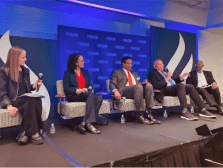Different makes us stronger: American diversity is a national security asset

There are many challenges facing the United States today that threaten the country’s global leadership and economic power. One of the most significant strategic challenges can be summed up as the Great Power Competition, where Russia represents an acute threat, and China, the premier pacing threat. Amidst these real-world challenges, the United States continues to have a special tool critical to its national security, and indeed, global leadership — the diversity of its people. The urgency that current threats pose requires U.S. policymakers to resist being drawn into self-defeating divisive politics. Instead, American diversity should be valued not only as an inherent good, but as a strategic asset.
The Great Power Competition is shaping up to be a race for technological dominance, and talent will be key to winning this race. America’s diverse untapped talent from populations typically underrepresented in technical fields presents a valuable asset that should not go unnoticed.
Historically, diverse communities have served as a core asset in advancing American dynamism and shaping American values. Decades of research shows that diverse teams build better products, diverse and inclusive companies deliver a stronger bottom line, and diverse militaries perform better on the battlefield. Indeed, uniting diverse, disparate communities as stakeholders, with shared destiny, is among the great triumphs of American culture. But persistent divisions and disparities have also left a great many communities among these same diverse populations — whether urban, rural, or tribal — vulnerable, lacking in resilience.
In today’s strategic competition, international adversaries actively seek to exploit divisions in novel and concerning ways. For instance, a bipartisan Senate Intelligence Committee report from 2019 found that Russia’s interference in the 2016 U.S. presidential election specifically targeted African Americans, stoking racial division in an “orchestrated effort” to drive down voter turnout.
In the emerging great power struggle, foreign threats are not the only challenge to be considered. Divisive domestic policies which counter efforts to leverage diversity are further entrenching the vulnerabilities that make these communities, and American society as a whole, susceptible to foreign adversaries. For example, outright bans of diversity efforts on college campuses, seemingly based on dubious research, are currently sweeping the nation, following the lead of the Florida legislature. These divisive prohibitions are misguided, to say the least. To be clear, fixes may well be in order for some of the diversity efforts rolled out in the aftermath of the 2020 murder of George Floyd — a period widely referred to as America’s “reckoning on race.” However, bans and prohibitions targeting diversity are particularly alarming at this time. Simply put, more talent from diverse, underrepresented domestic populations is needed to maintain advantage in ongoing strategic competition with very capable near-peer adversaries.
New data assembled by Georgetown University’s Center for Security and Emerging Technology shows that the United States is third among STEM producing countries behind China and India. In 2019, China graduated 1.6 million undergraduate students in STEM fields, compared to the U.S.’s 412,000, and by 2025 China will produce 77,000 STEM PhD graduates per year compared to approximately 40,000 in the United States. Every year, however, the United States leaves talent behind. In order to maintain advantage in global competition, this has to change. For example, while women account for 60 percent of college graduates, they only make up 40 percent of STEM graduates, and one quarter of graduates in AI fields. Statistics for other demographic groups and rural communities show similar trends. In addition to shoring up already robust existing pipelines of talent, U.S. policymakers must seize the opportunity to capture the invaluable, underrepresented talent left on the sidelines.
As a part of the solution, broad coalitions of government, industry and academia should join forces around technology-based economic development (TBED) that builds resilience in vulnerable communities. Employing TBED to capture this untapped talent will expand the lagging U.S. STEM talent pool, and build resilience within vulnerable communities. This resilience comes in the form of economic, social and civil stability that increases national security.
A representative model for generating TBED in an underserved community can be found in the National Robotics and Engineering Center (NREC) in Pittsburgh. When Carnegie Mellon University launched the NREC around 1994, the Lawrenceville neighborhood where it is located was underserved and underinvested. Today, the NREC sits at the center of “Robotics Row,” a dense collection of world-class robotics and autonomy companies and start-ups. Lessons learned in the success of TBED in transforming Lawrenceville can be applied elsewhere in the United States while simultaneously building resiliency in vulnerable communities by accessing the broad array of talent that exists everywhere in America.
In the emerging great power competition, technological leadership is a national security requirement, and a key to U.S. economic security. Due to intensifying worldwide strategic competition with capable near-peer adversaries, it is imperative that the United States maintain efforts to maximize production of high-quality AI and STEM talent. U.S. talent has to be better trained and more innovative than its global competitors. Untapped talent from U.S. populations typically underrepresented as stewards of technology presents a valuable asset for the country today. America’s diversity is once again poised to serve as a critical asset for U.S. national security and prosperity. In order to meet the moment, the U.S. must find a way to unleash its demographic riches.





